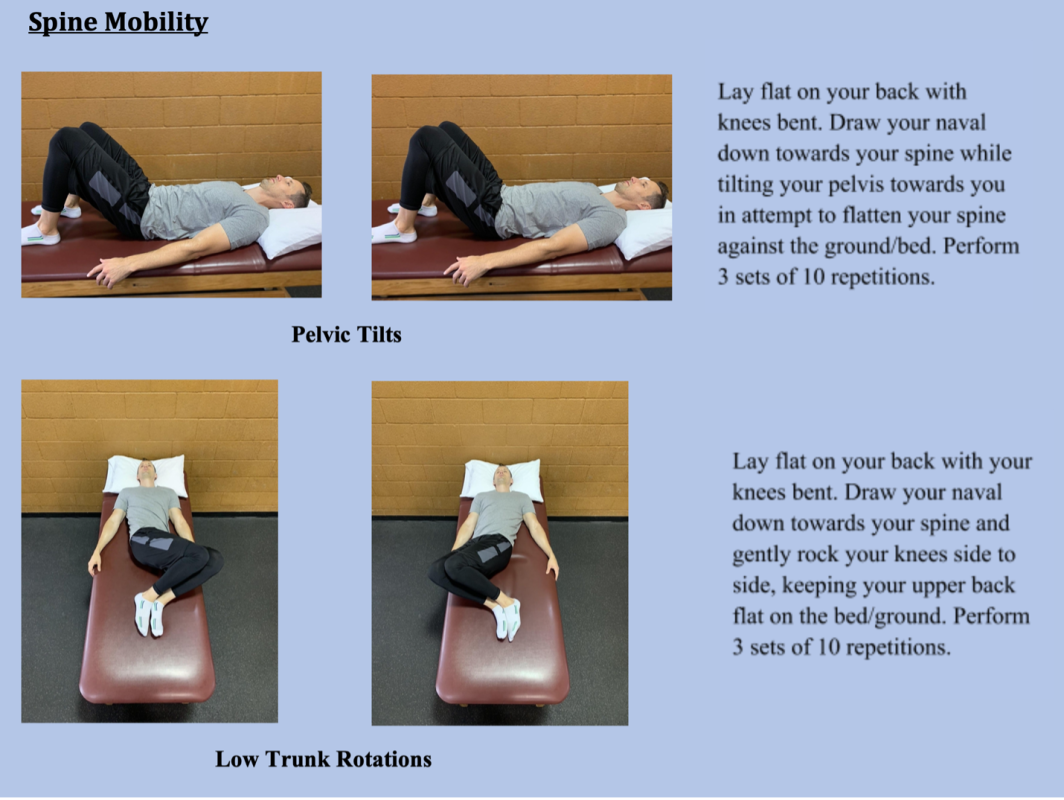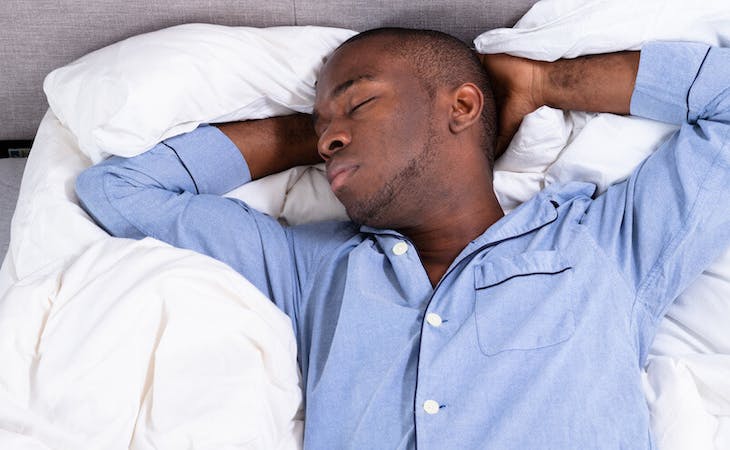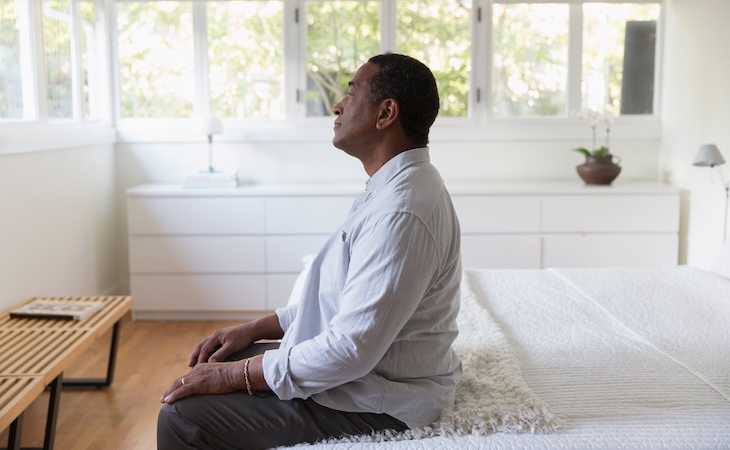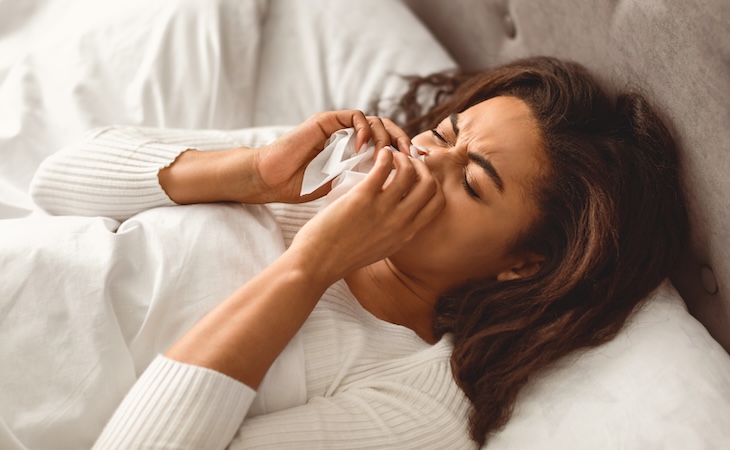Most experts agree that back sleeping is the best position for your body to sleep in. The thing is, only about 8% of people are actually back sleepers. [1]
Although side sleeping is the most common sleep position (and is a good option if you have acid reflux or sleep apnea), it does come with some downsides. Namely, side sleeping can put pressure on your hips, shoulders, and neck and cause back pain.
Stomach sleeping, meanwhile, is something most experts just don’t recommend at all. Stomach sleepers have to keep their head turned to be able to breathe. The 90-degree rotation of your head can put additional stress on the joints, ligaments, tendons, muscles, and nerves in your neck and upper thoracic spine. [2]
If you’re a side or stomach sleeper who deals with pain and discomfort at night, then you may want to consider making the switch to back sleeping.
Here, learn all about the benefits of back sleeping—plus, find out how to sleep on your back if it’s not something you’re in the habit of doing.
How to train yourself to sleep on your back in 5 easy steps
Changing up your sleep position and learning how to sleep in a new position can be difficult at first. But it’s well worth it if you’re continually waking up with back and neck pain in the morning.
Sleeping on your back provides many health benefits as it pertains to maintaining the natural curve of the spine. When the natural curve is supported during sleep, neck and back pain can become much more manageable.
Luckily, there are a few things you can do to make the transition easier. Try the following tips to train yourself to sleep on your back so you can start experiencing a good night’s sleep.
1. Choose the right mattress
The best mattress for back sleepers is typically a medium-firm mattress. Anything too soft may cause you to sink into the bed, while anything too firm may put pressure on your shoulders and back. [3, 4]
2. Find a supportive pillow
Beyond your mattress, the right pillow is also key. A commonly recommended pillow for back sleepers is a thinner to medium-thick pillow. This will help keep your head, neck, and spine properly aligned.
A thicker pillow may create undue stress surrounding the muscles of the neck, often resulting in waking up with stiffness in the neck.
3. Address your back pain
To better unload the lower back and decrease feelings of pressure and stiffness, try elevating your knees on top of a pillow 4-6 inches in height. This helps maintain alignment of the hips, in turn reducing low back pain discomfort.
Below are some safe exercises that can be incorporated to reduce tightness and stiffness of the lower back region. These can provide benefits when used before bed and even upon waking in the morning. As always, seek clearance from your healthcare practitioner to ensure you’re healthy enough for physical activity. [4]

4. Know that it’s OK to move around
Movement during sleep is natural, so if you start out your night in the proper sleeping position, that’s considered a great start.
If you end up on your side, remember that a pillow in between the knees and changing from one to two pillows under the head is recommended.
These simple tips can ensure spinal comfort regardless of what sleeping position you end up in.
5. Be patient
Transitioning from stomach or side to back sleeping won’t happen overnight. Each of the tweaks you make may take weeks to get used to.
There may also be a period of trial and error where you figure out what works best for you. But if you give yourself time to get used to your new sleep position, you’ll eventually be rewarded with healthier sleep.
Benefits of sleeping on your back
Back sleeping is ideal because it both keeps your head and spine in alignment, eliminating the pressure that contributes to aches and pains and allows your back muscles to relax.
This position is also excellent for people who complain of back pain and tightness. For people with acid reflux and heartburn, this position works well because it keeps your head above your airway. [6] However, to have your head elevated correctly, you need the right pillow or adjustable bed.
Sleeping on your back helps prevent acne by keeping your face away from your pillowcase. Additionally, back sleepers are less prone to sleep wrinkles. [5] Stomach and side sleepers often wake up with creases on the side of the face they lie on. These creases can cause wrinkles on your face over time. [7] (Here’s why you should sleep on your back if you have a new ear piercing.)
Best types of mattresses for back sleepers
Part of training yourself to sleep on your back includes finding the right mattress. You already know that a medium-firm mattress is ideal for back sleepers—now it’s time to consider the mattress type.
Innerspring, hybrid, memory foam, and latex foam mattresses can all be good options for back sleepers—but there are a few things you’ll want to keep in mind when selecting a new mattress.
Above all, you want a mattress that provides a balance of comfort and support for your upper body and lower body. Both memory foam and latex foam contour to your body and cradle your spine. This contouring ability can make memory foam and latex particularly comfortable for back sleepers.
However, some back sleepers find that memory foam has too much give, causing you to “sink in.” In that case, a latex mattress or a hybrid mattress with a foam comfort layer for extra cushioning might be a better option.
Frequently asked questions
Should pregnant women sleep on their back?
Sleeping on your back, especially during the later stages of pregnancy, has been shown to potentially be associated with negative risks both to the pregnant person and baby. [7]
Consider sleeping on your side with one to two pillows between your legs or under your abdomen. This will ensure greater comfort and safer sleep during the third trimester.
Start sleeping better with a new mattress from Saatva
Back sleeping is the healthiest sleep position for many people—it can help reduce back pain, relieve sinus buildup, and prevent sleep wrinkles. Overall, it’s healthy to train yourself to sleep on your back.
Saatva offers a wide variety of mattresses and bed accessories to help you get comfortable while learning to sleep on your back. Take our online mattress quiz to find the best mattress for your sleep style and ideal position. All of our mattresses come with a 365-night home trial and industry-leading warranty.
References
- Cary D, Jacques A, Briffa K. Examining relationships between sleep posture, waking spinal symptoms and quality of sleep: A cross sectional study. PLoS One. 2021 Nov 30;16(11):e0260582. doi: 10.1371/journal.pone.0260582. PMID: 34847195; PMCID: PMC8631621.
- Cary D, Briffa K, McKenna L. Identifying relationships between sleep posture and non-specific spinal symptoms in adults: A scoping review. BMJ Open. 2019 Jun 28;9(6):e027633. doi: 10.1136/bmjopen-2018-027633. PMID: 31256029; PMCID: PMC6609073.
- Ahmed Radwan, Philip Fess, Darcy James, John Murphy, Joseph Myers, Michelle Rooney, Jason Taylor, Alissa Torii. Effect of different mattress designs on promoting sleep quality, pain reduction, and spinal alignment in adults with or without back pain; systematic review of controlled trials. Sleep Health, Volume 1, Issue 4, 2015. Pages 257-267. ISSN 2352-7218.
- Kovacs, FM. “Effect of firmness of mattress on chronic non-specific low-back pain.” Lancet, November 2003.
- Goesel Anson, Michael A.C. Kane, Val Lambros, Sleep Wrinkles: Facial Aging and Facial Distortion During Sleep, Aesthetic Surgery Journal, Volume 36, Issue 8, September 2016, Pages 931–940, https://doi.org/10.1093/asj/sjw074
- Albarqouni L, Moynihan R, Clark J, Scott AM, Duggan A, Del Mar C. Head of bed elevation to relieve gastroesophageal reflux symptoms: a systematic review. BMC Fam Pract. 2021 Jan 19;22(1):24. doi: 10.1186/s12875-021-01369-0. PMID: 33468060; PMCID: PMC7816499.
- Robertson N, Okano S, Kumar S. Sleep in the Supine Position during Pregnancy Is Associated with Fetal Cerebral Redistribution. J Clin Med. 2020 Jun 7;9(6):1773. doi: 10.3390/jcm9061773. PMID: 32517385; PMCID: PMC7356729.







